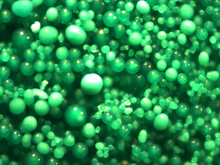
Copper oxychloride

Nutrilock Tribasic Copper ChlorideMicronutrients TBCCIntellibond CCopper HydroxychlorideParatacamite: rhombohedral Dicopper chloride trihydroxide is the chemical compound with the formula Cu2(OH)3Cl. It is often referred to as tribasic copper chloride (TBCC), copper trihydroxyl chloride or copper hydroxychloride. It is a greenish crystalline solid encountered in mineral deposits, metal corrosion products, industrial products, art and archeological objects, and some living systems. It was originally manufactured on an industrial scale as a precipitated material used as either a chemical intermediate or a fungicide. Since 1994, a purified, crystallized product has been produced at the scale of thousands of tons per year, and used extensively as a nutritional supplement for animals. Dicopper chloride trihydroxide is the chemical compound with the formula Cu2(OH)3Cl. It is often referred to as tribasic copper chloride (TBCC), copper trihydroxyl chloride or copper hydroxychloride. It is a greenish crystalline solid encountered in mineral deposits, metal corrosion products, industrial products, art and archeological objects, and some living systems. It was originally manufactured on an industrial scale as a precipitated material used as either a chemical intermediate or a fungicide. Since 1994, a purified, crystallized product has been produced at the scale of thousands of tons per year, and used extensively as a nutritional supplement for animals. Cu2(OH)3Cl occurs as natural minerals in four polymorphic crystal forms: atacamite, paratacamite, clinoatacamite, and botallackite. Atacamite is orthorhombic, paratacamite is rhombohedral, and the other two polymorphs are monoclinic. Atacamite and paratacamite are common secondary minerals in areas of copper mineralization and frequently form as corrosion products of Cu-bearing metals. The most common Cu2(OH)3Cl polymorph is atacamite. It is an oxidation product of other copper minerals, especially under arid, saline conditions. It was found in fumarolic deposits, and a weathering product of sulfides in subsea black smoker deposits. It was named for the Atacama Desert in Chile. Its color varies from blackish to emerald green. It is the sugar-like coating of dark green glistening crystals found on many bronze objects from Egypt and Mesopotamia. It has also been found in living systems such as the jaws of the marine bloodworm Glycera dibranchiate. The stability of atacamite is evidenced by its ability to endure dynamic regimes in its natural geologic environment. Paratacamite is another Cu2(OH)3Cl polymorph that was named for the Atacama Desert in Chile. It has been identified in the powdery light-green corrosion product that forms on a copper or bronze surface – at times in corrosion pustules. It can be distinguished from atacamite by the rhombohedral shape of its crystals. Botallackite is the least stable of the four Cu2(OH)3Cl polymorphs. It is pale bluish-green in color. This rare mineral was first found, and later identified, in the Botallack Mine in Cornwall, England. It is also a rare corrosion product on archaeological finds. For instance, it was identified on an Egyptian statue of Bastet. The fourth polymorph of Cu2(OH)3Cl family is clinoatacamite. It was found and identified around in Chuquicamata, Chile in 1996. It was named in allusion to its monoclinic morphology and relationship to atacamite. It too is pale green but has monoclinic crystals. Clinoatacamite can be easily confused with the closely related paratacamite. It is believed that clinoatacamite should replace most previously reported occurrences of paratacamite in the conservation literature. Atacamite is orthorhombic, space group Pnma, with two crystallographically independent Cu and hydroxyl oxygen atoms in the asymmetric unit. Both Cu atoms display characteristically Jahn-Teller distorted octahedral (4+2) coordination geometry: each Cu is bonded to four nearest OH groups with Cu-OH distance of 2.01Å; in addition, one of Cu atoms is bonded to two Cl atoms (at 2.76Å) to form a octahedron, and the other Cu atom is bonded to one Cl atom (at 2.75Å) and a distant OH group (at 2.36Å) to form a octahedron. The two different types of octahedron are edge-linked to form a three-dimensional framework with the octahedron cross-linking the octahedron layers parallel to (110) (Figure 1). Botallackite crystallizes in monoclinic with space group P21/m. Like in atacamite, there are two different types of Cu coordination geometries: Jahn-Teller distorted octahedral and . But these octahedra assemble in different ways. Each octahedron shares six edges with surrounding octahedra, forming a two-dimensional sheet-type structure parallel to (100). The adjacent sheets are held together by hydrogen bonding between the hydroxyl oxygen atoms of one sheet and the opposing chlorine atoms in the other sheets. The resulting weak bonding between the sheets accounts for the perfect (100) cleavage and the typical platy habit of botallackite (Figure 2). Paratacamite is rhombohedral, space group R3. It has a well-developed substructure with a’=a/2, c’=c, apparent space group R3m. There are four crystallographically independent Cu atoms in the asymmetric unit. The Cu atoms display three different types of octahedral coordination geometries. Three quarters of the Cu atoms are coordinated to four near OH groups and two distant Cl atoms, giving the expected (4+2) configuration . Three sixteenths of the Cu atoms are bonded to two near OH groups at 1.93Å and four stretched OH groups at 2.20Å to form an axially compressed (2+4) octahedral , and the remaining one sixteenth of the Cu atoms are bonded to six equivalent OH groups at 2.12Å to form a regular octahedral . The Jahn-Teller distorted octahedra share the edges and form partially occupied layers parallel to (001), and the compressed and regular octahedra cross-link the adjacent octahedral layers to form a three-dimensional framework. The existence of the regular octahedral is unusual, and it has been shown that partial substitution of Zn or Ni for Cu at this special site (3b) is necessary to stabilize paratacamite structure at ambient temperature. Due to the high symmetry of the special position, only about 2 wt% Zn is necessary to stabilize the rhombohedral structure. In fact, most of paratacamite crystals studied contain significant amounts of Zn or Ni (>2 wt%) (Figure 3).
